Proposal to Implement Tourist Ban at Australia’s Largest Lake Raised
Under a proposed management plan, all recreational access to the lake bed will be banned out of respect for Arabana culture.
Visitors will no longer be able to set foot on one of Australia’s premier tourist destinations under a proposed plan to protect its cultural significance for traditional owners.
Kati Thanda-Lake Eyre is the continent’s largest lake.
Every few years it breaks out into a spectacular kaleidoscope of colours when flooding rains from Queensland fill the immense saltwater basin, transforming the bleak desert landscape into an oasis of flowers and birds and attracting scores of tourists.
But it is a sacred site for the Arabana people, who have lived in the region for millennia and are the lake’s native title holders.
Under a proposed management plan, all recreational access to the lake bed will be banned out of respect for Arabana culture.
Their lore considers it dangerous to visit the lake without the guidance of cultural authority.
Swimming, driving, boating and landing aircraft on the lake are already banned, but the new plan would prevent visitors from setting foot on its bed without permission.

“We have a responsibility to look after the lake and in turn, it looks after us,” she said.
“Preservation of this lake is also the preservation of our culture.”
While many tour operators already avoid walking out onto the lake for logistical reasons, Australian Iconic Tours owner and director Flick Builder said visitors still valued the experience.
“It’s the only place in Australia where you can stand dryly below sea level,” she told AAP.
“It’s just an experience that people enjoy as part of our five-day tours.
“There would be some people that would probably be a bit disappointed – that’s why it’s something I hope that we would be able to continue.”
Kati Thanda-Lake Eyre is one of several culturally significant sites in SA to enforce strict rules around entry to visitors, including Koonalda Caves in the Nullarbor, Sacred Canyon in Ikara-Flinders Ranges, and Ngaut Ngaut Conservation Park.
Ms Builder says the company already works with Indigenous land councils to conduct tours in other culturally significant sites and hopes to reach an agreement with the Arabana Aboriginal Corporation to continue offering walks out into the lake in a respectful way.
“Whether or not we need to do some training in the cultural significance of Kati Thanda to the Arabana people is something we’d be open to exploring,” she said.
National Parks and Wildlife Service program director Jason Irving said the South Australian government was committed to its partnership with the Arabana people.
“The request for visitors not to enter a sacred cultural site is made in recognition and respect for Arabana culture and to ensure the safety of visitors,” he said.





